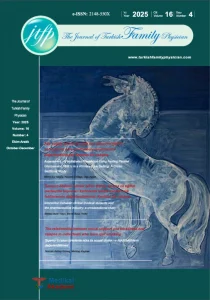Current information on Vitamin D deficiency
In the world, the frequency of vitamin D deficiency is increa-sing and it is estimated that there is a vitamin D deficiency in people close to 1 billion. The prevalence is between 40% and 100% and the highest prevalence is found in North Asia and Middle East regions. Vitamin D deficiency is also seen in our country. Therefore, the number of researches on the subject is increasing and there is a frequent relationship between vitamin D deficiency and musculoskeletal pain, osteoporosis, diabetes mellitus, hypertension, cardiovascular diseases, autoimmune diseases, sleep disorders, cancer and increased mortality.
Although screening of whole population is not recommended in terms of vitamin D deficiency, it is recommended to measure serum 25(OH)D levels in risky groups. Aging, dark skin color, obesity, spontaneous fracture formation, chronic renal failure, working indoors are risk factors for vitamin D deficiency.
Vitamin D is an important vitamin for human health and its deficiency is associated with serious health problems. Therefore, it is of great importance to determine the vitamin D deficiency which is easily preventable and treatable. Although there are many researches on the subject in the world, there is not enough research in our country. In our country, researches that will be planned based on society, especially in risk groups, are of great importance for public health.
References
- Türkiye Endokrinoloji ve Metabolizma Derneği. Osteoporoz ve Metabolik Kemik Hastalıkları Tanı ve Tedavi Kılavuzu 2018: 119-27.
- Hossein-nezhad A, Holick MF. Vitamin D for health: A Global perspective. Mayo Clin Proc 2013 July; 88(7):720–55. doi:10.1016/j.mayocp.2013.05.011.
- Hossein-nezhad A, Holick MF. Optimize dietary intake of vitamin D: an epigenetic perspective. Curr Opin Clin Nutr Metab Care 2012;15(6):567–79.
- Hossein-nezhad A, Spira A, Holick MF. Influence of vitamin D status and vitamin D3 supplementation on genome wide expression of white blood cells: a randomized double-blind clinical trial. PLoS One 2013;8(3):e58725.
- Holick MF. Vitamin D deficiency. N Engl J Med 2007;357(3):266–81.
- Melamed ML, Michos ED, Post W, Astor B. 25Hydroxyvitamin D levels and the risk of mortality in the general population. Arch Intern Med 2008;168:1629–37. doi:10.1001/ archinte.168.15.1629.
- Autier P, Boniol M, Pizot C, Mullie P. Vitamin D status and ill health: a systematic review. Lancet Diabetes Endocrinol 2014;2:76–89. doi:10.1016/S2213-8587(13)70165-7
- Holick MF. Sunlight and vitamin D for bone health and prevention of autoimmune diseases, cancers, and cardiovascular disease. Am J Clin Nutr 2004; 80:1678–88.
- Kendrick J, Targher G, Smits G, Choncho M. 25Hydroxyvitamin D deficiency is independently associated with cardiovascular disease in the Third National Health and Nutrition Examination Survey. Atherosclerosis 2009;205:255–60. doi:10.1016/j. atherosclerosis.2008.10.033.
- Dawson-Hughes B. Vitamin D deficiency in adults: definition, clinical manifestations, and treatment. http://www.uptodate.com/2017 adresinden 02.03.2019 tarihinde erişilmiştir.
- Forrest KY, Stuhldreher WL. Prevalence and correlates of vitamin D deficiency in US adults. Nutr Res 2011; 31(1):48-54.
- Lips P. Vitamin D status and nutrition in Europe and Asia. J Steroid Biochem Mol Biol 2007;103:620-5.
- Mithal A, Wahl DA, Bonjour JP, et al. Global vitamin D status and determinants of hypovitaminosis D. Osteoporos Int 2009; 20:1807.
- Sowah et al. Vitamin D levels and deficiency with different occupations: a systematic review. BMC Public Health 2017;17:519. doi: 10.1186/s12889-017-4436-z.
- Alagöl F, Shihadeh Y, Boztepe H, Tanakol R, Yarman S, Azizlerli H, Sandalci O. Sunlight exposure and vitamin D deficiency in Turkish women. J Endocrinol Invest 2000;23(3):173-7.
- Hekimsoy Z, Dinç G, Kafesçiler S, Onur E, Güvenç Y, Pala T, et al. Vitamin D status among adults in the Aegean region of Turkey. BMC Public Health 2010;10:782.
- Cigerli O, Parildar H, Unal AD, Tarcin O, Erdal R, Guvener DN. Vitamin D deficiency is a problem for adult out-patients? A university hospital sample in Istanbul, Turkey. Public Health Nutr 2013;16(7):1306-13.
- Atli T, Gullu S, Uysal AR, Erdoğan G. The prevalence of Vitamin D deficiency and effects of ultraviolet light on vitamin D levels in elderly Turkish population. Arch Gerontol Geriatr 2005;40:53–60.
- Oğuz S, Çamcı G, Arpacıoğlu Y, Şeker M, Erbek H, Yurtdaş M. Bir aile sağlığı merkezine başvuran bireylerin obezite durumunun belirlenmesi. JAREN 2019;5(1):10-16. doi:10.5222/jaren.2019.69672.
- Cinar N, Harmanci A, Yıldız BO, Bayraktar M. Vitamin D status and seasonal changes in plasma concentrations of 25-hydroxyvitamin D in office workers in Ankara, Turkey. European Journal of Internal Medicine 2014;25:197-201.
- Özdemir O, Ocaktan E, Akdur R. Sağlık Reformu Sürecinde Türkiye ve Avrupa’da Birinci Basamak Sağlık Hizmetlerinin Değerlendirilmesi. Ankara Üniversitesi Tıp Fakültesi Mecmuası 2003; 56 (4); 207-16.
- Primary Care Guidelines for the Management of Vitamin D Deficiency in Adults April 2017. www.croydonccg.nhs.uk adresinden 25/07/2018 tarihinde erişilmiştir.
- Department of Health and Social Care, Isle of Man. Vitamin D: supplementation, measurement and treatment in primary care. https://www.gov.im/media/1359531/dhsc45-vitamin-d-supplementation-measurement-and-treatment-in-primary-c-v2.pdf adresinden 25/07/2018 tarihinde erişilmiştir.
- Weishaar T. How do primary care physicians and practitioners view and implement vitamin D in their practice? www.vitamindcouncil.org/how-do-primary-care-physicians-and-practitioners-view-and-implement-vitamin-d-in-their-practice/ adresinden 07/07/18 tarihinde erişilmiştir.
- Kenneth W. Lin. Vitamin D Screening and Supplementation in Primary Care: Time to Curb Our Enthusiasm. American Family Physician 2018; 97 (4): 226-7.
- Zhao S, Gardner K, Taylor W, et al. Vitamin D assessment in primary care: changing patterns of testing. London Journal of Primary Care 2015;7:15–22.



